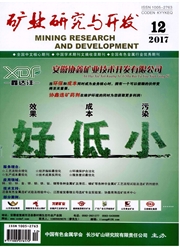

 中文摘要:
中文摘要:
The subcritical crack growth and fracture toughness in peridotite, lherzolite and amphibolite were investigated with double torsion test. The results show that water-rock interaction has a significant influence on subcritical crack growth. With water-rock interaction, the crack velocity increases, while the stress intensity factor declines, which illustrates that water-rock interaction can decrease the strength of rocks and accelerate the subcritical crack growth. Based on Charlse theory and Hilling & Charlse theory, the test data were analyzed by regression and the correlation coefficients were all higher than 0.7, which shows the correlation is significant. This illustrates that both theories can explain the results of tests very well. Therefore, it is believed that the subcritical crack growth attributes to the breaking of chemical bond, which is caused by the combined effect of the tensile stress and the chemical reaction between the material at crack tip and the corrosive agent. Meanwhile, water-rock interaction has a vital effect on fracture toughness. The fracture toughness of samples under atmospheric environment is higher than that of samples immersed in water. And water-rock interaction has larger influence on fracture toughness in amphibolite than that in peridotite and lherzolite.
 英文摘要:
英文摘要:
The subcritical crack growth and fracture toughness in peridotite, lherzolite and amphibolite were investigated with double torsion test. The results show that water-rock interaction has a significant influence on subcritical crack growth. With water-rock interaction, the crack velocity increases, while the stress intensity factor declines, which illustrates that water-rock interaction can decrease the strength of rocks and accelerate the subcritical crack growth. Based on Charlse theory and Hilling Charlse theory, the test data were analyzed by regression and the correlation coefficients were all higher than 0.7, which shows the correlation is significant. This illustrates that both theories can explain the results of tests very well. Therefore, it is believed that the subcritical crack growth attributes to the breaking of chemical bond, which is caused by the combined effect of the tensile stress and the chemical reaction between the material at crack tip and the corrosive agent. Meanwhile, water-rock interaction has a vital effect on fracture toughness. The fracture toughness of samples under atmospheric environment is higher than that of samples immersed in water. And water-rock interaction has larger influence on fracture toughness in amphibolite than that in peridotite and lherzolite.
 同期刊论文项目
同期刊论文项目
 同项目期刊论文
同项目期刊论文
 期刊信息
期刊信息
